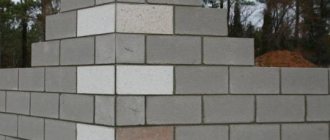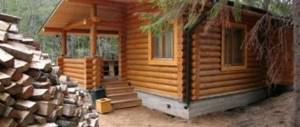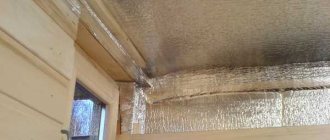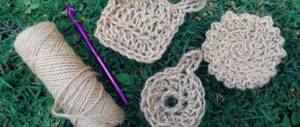Receive an individual offer!
Limited offer!
By clicking “Get an offer”, you confirm that you have read the terms of the privacy policy and consent to the processing of personal data.
Or call our managers
- home
- /
- Articles
- /
- What kind of wood to build a bathhouse from?
Wood creates a useful and comfortable microclimate for humans in a bathhouse, but at the same time it is one of the most complex and “capricious” building materials.
Under the influence of moisture and temperature changes, wood cracks, swells or even rots; its strength, in comparison with other building materials, is lower.
In SNiP “Fire Safety of Buildings and Structures,” wooden buildings are classified as a high-risk class.
In this regard, the choice of wood for the construction of even the simplest structures, including bathhouses, must be approached especially carefully.
When choosing wood for building a bathhouse, it is necessary to take into account the specifics of the room itself:
- Humid environment - not all wood species are resistant to constant exposure to moisture, and the wood you choose for building a bathhouse may eventually rot.
- Temperature changes - a large difference in temperature inside and outside, characteristic of baths, can lead to cracking of wood, its drying out or, conversely, swelling. Any deformation of the building material inevitably leads to a decrease in the strength of the entire structure.
Accordingly, wood as a building material for a bathhouse must have the following characteristics:
- Resistance to high humidity and constant dampness
- Resistance to fungal infections
- Resistant to cracking and warping due to direct contact with water
- Physical and mechanical strength
There are no types of wood in nature that have all these characteristics at the same time. Any shortcomings (for example, the natural vulnerability of most types of wood to deformation when exposed to humidity or temperature changes) are compensated by the use of modern building materials. So, instead of ordinary timber, which undergoes minimal processing, today glued laminated timber is increasingly used in the construction of wooden structures. But often you have to choose the optimal types of wood for building a bathhouse, “turning a blind eye” to some minor shortcomings.
The most common types of wood for building baths are:
- Pine
- Larch
- Oak
- Aspen
Sometimes fundamentally different species are used to build the walls of a bathhouse and its interior decoration - therefore, when planning the construction of a bathhouse on a site, it will most likely be necessary to select several options for wood building materials.
Each of them has both its advantages and inevitable disadvantages. Let's figure out which tree is best to choose for a bathhouse.
Log house: what kind of wood is best to build from?
In countries with large forested areas, a centuries-old tradition of constructing wooden structures has developed. Therefore, you can calmly rely on the experience of your ancestors, but at the same time keep in mind that the modern bathhouse is different from the one that was common a couple of centuries ago . With this amendment we will proceed to the description.
The conclusion that you come to after studying a variety of species is disappointing for many: the best wood for a bathhouse is cedar pine round timber. The disappointing thing about this is that the construction of such a bathhouse is beyond the financial capabilities of many people. But if funds allow, this is an excellent investment.
Siberian cedar. (Photo: LesAllianceTorgBO)
You will have to invest a lot of money in a bathhouse built from oak - in such a bathhouse there is no need for internal lining at all, because hardwood was chosen, which does not emit resin. Oak has high strength and hardness. This is a dense tree that is difficult to cut. By the way, it creates an increased load on the foundation, which must be made stronger than for other log houses.
Recommendation! Spend at least a little money on oak or larch, using them as the lower crowns of a log house - this is a very good solution if all the other crowns are made of less resistant wood. The log house always begins to rot from the lower crowns and window sills.
Larch is also a good choice, but don't rely solely on sellers' claims that it is flawless - it doesn't rot at all. We never tire of repeating that everything rots - all species and all parts of trunks (the core is the same as sapwood). Therefore, good ventilation, protection of the log house from the outside, preventive measures, etc. are needed.
And all the same, larch’s own resistance is great compared to other species. Therefore, the log house for the bathhouse will be more durable.
ADVICE! When building from coniferous trees, do not forget that they emit resin. Therefore, in a steam room you need to be prepared for the fact that you will have to cover the beautiful walls of the log house with cladding made of hardwood. This is in case the release of resin from high temperature begins to cause real inconvenience. It is better to immediately sheathe the ceiling with hardwood.
We have already said that oak is a deciduous tree. But in Russia there is a long tradition of building log houses from aspen. And this despite the fact that this tree is easily rotten. We have a hypothesis: since there were no chimneys before, the smoke from the stove spread throughout the room, the soot settled on the walls, simultaneously disinfecting them. Therefore, even unstable wood lasted a long time.
However, you can ensure the conditions for the durability of an aspen log house if the lower crowns and window sill beams from more resistant species, treat the outside with an antiseptic, and do not forget to throw in a log inside to dry the bath after the procedures. Then the aspen will serve you for decades. And if you do nothing at all, then both cedar and larch can rot.
People often ask whether it would be better to make a log house for a bathhouse from pine ? It depends on which side it is better: in terms of finances, you can, of course, benefit from a significant budget reduction. This is a big plus for many. In addition, pine is a structural material ; important parts are made from it, that is, this tree is suitable for construction. But it releases a lot of resin (they say about cedar that you don’t even need to cover it in a steam room, but pine is very desirable). Therefore, it may be better to build a bathhouse from pine wood, but the finishing inside the steam room should be made from aspen or linden.
An alternative to pine is spruce , but it has its pros and cons. It is less dense than pine, which is good, because it will have lower thermal conductivity and will retain heat better. But it has many knots that spoil the instrument and reduce the insulating qualities of the material. They also say that spruce produces less resin than pine and is saturated with less water.
In general, there is simply no clear answer to the question of which tree is best for a bathhouse - it all depends on the financial capabilities of the owner.
Linden is sometimes used as a building material, but the tree is fragile, soft and prone to rotting, so follow the same tips that apply to aspen. Birch is also not suitable - it is prone to rotting.
Why tree
Wood for a bath
Speaking about the construction of a wooden bathhouse, we can distinguish three options for buildings.
- Panel.
- Made from rounded logs.
- Log house made of timber.
In terms of practicality of work and economic indicators, the third option is considered more profitable, for which there are the following explanations.
- Laying timber is not a difficult job, and it is quite possible to do it yourself, without resorting to the help of expensive specialists.
- Unlike a rounded log house, the shrinkage of the timber is minimal and amounts to no more than 10 mm.
- A log house is much cheaper, and any room can be made from it in size.
- Assembly can be carried out directly on the foundation.
Which wood is better for cladding?
Let's start with the fact that the cladding can be internal and external. And the material from which the walls are built can be anything. That is, it is understandable when the owner built it from brick or concrete blocks, and then lined the bathhouse inside and outside with wood, so that there would be less worries than about a log house, and the traditional look of the bathhouse would be preserved. The frame is also covered with wood. But it also happens that they are built from round timber or timber, and then covered with clapboard.
They do this for two reasons : either it turned out that the beam or log is too thin and does not retain heat, and they need to be insulated, or they were built from pine needles, and they began to cry with resin and began to spoil the pleasure of taking bath procedures. In the second case, insulation can be done or not done, depending on whether it is necessary to raise the temperature in winter.
A bathhouse made of timber is lined with herringbone edged boards
So there are also significant reasons, so we won’t be immediately upset when we learn that someone covered a log with clapboard. Well, in all other cases there was no other choice - don’t leave the brick wall bare!
Internal lining
Let's start with the inner lining - it is done most often, for the reasons described above. lining is also used . Moreover, it can be used in any room. However, the wood from which this lining is made may vary depending on the purpose of the room and the temperature conditions in it.
In addition to lining, the cladding can be made of boards - edged or unedged, but cleared of wane and sanded.
You can read about lining here, about finishing with unedged boards - here.
How to cover a steam room
The steam room is the most problematic place in the bathhouse. Due to the high temperature, you should not use conifers there, and due to the high humidity, deciduous ones will rot there, again, if you don’t take too much care of them.
Again, it is difficult to say unequivocally which wood is better to cover a steam room in a bathhouse - we are inclined to aspen, if it is of high quality (without rot), linden is in second place, and is in third place . the properties of ash , but its characteristics are simply excellent - in terms of hardness and resistance to rotting. It is worth consulting with experts how ash will behave in a steam room.
IMPORTANT! Birch should not be used either for construction or for finishing wet rooms - it is a type of wood that quickly rots upon temporary contact with water.
partially (!) line the steam room with cedar - just for the smell. At the same time, check whether it really does not emit resin as advertised. A square meter of cedar board is enough to smell the aroma.
In the washing room
The washing room differs from the steam room in that it has a much lower temperature, but higher humidity, and direct contact of wood with water.
Here, to the question “which tree is best for a bathhouse in a washing room,” we will answer that larch. The temperatures are suitable, and she is not afraid of direct contact with water. So you can safely use it to cover the washing area.
Lining made of unimpregnated larch
However, this is still an expensive option. Other conifers can also be used in this room. The fact is that such an unpleasant - hot and sticky - resin increases the wood's ability to resist rotting. But this ability is not unlimited. Don’t rely only on it - treat the wood with water-repellent impregnations, and it will stop absorbing moisture as before, and therefore will crack less when drying.
BY THE WAY ! It is expensive, but very useful due to the special substance contained in thuja, to use Canadian red cedar - it is not actually a cedar, but a thuja. Very beautiful, durable, expensive and healthy. We conducted an investigation, it actually contains a substance that kills fungi and bacteria.
Deciduous in the washroom... we no longer have a reason to use wood that is not resistant to fungi just because it doesn't contain resin. Still, deciduous wood is used for a bath for its intended purpose only in a steam room.
Which one to use in other rooms?
The remaining rooms are a relaxation room, a dressing room, a bathroom and a veranda. Something may not happen, of course, but we will tell you about everyone.
Condensation can accumulate in the dressing room It's cold and damp there. Use softwood . But it is highly advisable not to allow them to swell. If the tree swells and is then exposed to frost, the ice will tear the wood! Because the volume of ice is greater than the volume of liquid.
ADVICE! Make the door airtight and it is better if it is insulated and non-metallic. And cover the wood itself with primer and varnish or paint. Or at least make it water-repellent.
In the recreation room, wooden paneling serves primarily a decorative function. Therefore, here the owner is free to choose any breed that will attract his attention with its texture, color, and style. The difference between coniferous and deciduous does not matter , because there are no restrictions on coating with paint and varnish products. Anything intended for residential interiors is applicable.
ATTENTION! Even pine, when cut tangentially (see what it is, see here) gives a very beautiful texture, moiré patterns.
As for the bathroom, it is unlikely that anyone will choose separate wood; rather, the remnants of the one purchased for cladding the bathhouse as a whole will be used.
But as for the veranda , it is worth clarifying what kind of veranda - insulated with glazing or open, like a gazebo.
In the first case, you can not hesitate to use the same wood that is best for the bathhouse as a whole in your opinion. From the inside, of course. Because an insulated enclosed veranda is a full-fledged interior space.
But if it is open, then it is affected by water and air, sun, precipitation, and wind. Here the choice is limited to those species or materials that are specially created for use in harsh conditions.
It is better to make the bathhouse terrace from larch wood. Or from impregnated pine. A wood-polymer composite can also be considered as an alternative All of these are options for laying the floor of a terrace or veranda. Accordingly, you should use either a terrace or a deck board for this.
What breed is used to sheathe the facade?
Russia has its own specifics when it comes to wood paneling of facades. If in the West planken or “American” type lining is more often used for this purpose, then in our country it is either a board (edged or unedged) or lining, but rather an ordinary thicker one than “American”.
However, all of the listed types of cladding are quite suitable for the intended purpose.
If we try to name the best wood for an outdoor bathhouse... then we would name Canadian red cedar - also an expensive pleasure, but with pronounced health benefits for the wood itself, for the facade, and for the owner. Because it is not just beautiful wood, but also has antiseptic properties: both a fungicide and a bactericide.
Otherwise, everything again depends solely on your budget. One could say that the wood that is best used for an outdoor bath is thermal wood. It does not absorb moisture and is not afraid of pests. But practice shows that any wood outside requires a coating.
And such a coating should protect it from ultraviolet radiation. In addition to thermowood, impregnated boards can be an attractive option . But it also needs varnishing or impregnation. (Yes, and as we found out in this article, “Tanalit” is not a panacea for all types of mushrooms.)
We recommend options that are best suited for an aggressive external environment. But nothing prevents you from using ordinary wood, not overheated or impregnated in industrial conditions, which has been used for centuries and was normal. If it is a coniferous species, then it will hold up better, but it will also cry like resin in the sun. Deciduous ones don’t cry, but they don’t last long without protection. Therefore, antiseptic and varnish are desirable.
Which one is better to make floors from?
It is best to make the floors in the bathhouse from larch wood. This is the best option, because the temperature near the floor is always low, so there is no risk of resin release there. And if water pours onto the floor, then larch will withstand such an attack better than other species. However, this does not eliminate the need for thoroughly drying the bath. Because larch (and many other species) behaves well with constant contact with water, but water-air is still fraught with decay for it.
BY THE WAY! It is not necessary to make the floors of the entire bathhouse from expensive larch; you can limit yourself to only the steam room and washing room.
In other rooms, much less moisture gets on the floor and you can use a standard floorboard, for example, spruce or pine . See also the article: What is the best material to make a steam room floor from: tips, instructions, diagrams and videos.
Alder
The color of the wood when cut is white, later - yellow, orange. Over time, the wood turns gray. If we talk about old wood, then by treating with drying oil or oil you can achieve a natural color for alder. The wood is viscous, soft, light, does not splinter, but cuts well, is not fragile, and does not crack when dried. One of the negative properties of this type of wood is the difficulty of drilling, as well as the brown stripes found in solid alder. The advantage of alder is its excellent resistance to moisture.
Windows and doors
A double-glazed window in a bathhouse is a necessary thing, but you shouldn’t put it in a plastic frame. Because plastic in a bathhouse is not only a source of harmful substances released when heated. When heated, it also increases in size, and when strongly cooled, it can crack. Of course, this can be compensated for by various additives to PVC, but then you need to be confident in the manufacturer.
We believe that the best option for a bathhouse is wood for both windows and doors. And for entrance doors as well. Because iron doors in a bathhouse in winter are a source of condensation.
But windows and doors have one feature that does not go well with wood - it swells when absorbing moisture, after which the window or door may not fit into the opening. When dry, of course, the dimensions are restored, but cracking is possible.
What wood is best to use for a bathhouse when choosing windows and doors? With minimal change in dimensions when moistened and dried. linden plays this role but our study of reference data showed that aspen is even better in this regard.
But the Finns have long switched to thermal wood, which they use for door frames and window frames. Since heat-treated wood dries down to 6%, it is no longer able to absorb moisture and change dimensions. A very valuable property precisely for those items that are now being discussed. So, if possible, we recommend paying attention to thermal wood.
Another interesting observation made when studying the properties of cedar pine is that its coefficients of change in linear dimensions are even smaller than those of linden and aspen. Therefore, it is also a candidate material for windows and doors.
More materials about windows and doors: Windows for saunas and baths, Doors for baths.
Do-it-yourself technology and stages of construction
Foundation
The bathhouse construction technology involves pouring the foundation. After calculating the estimate, choosing a location and consumables, you need to begin this process.
A foundation is required for the existence of every structure. Many people have a question: how to fill it? It is poured in accordance with the weight of the building. The weight depends on the consumable material used to construct the walls.
It is not recommended to save money on the foundation, because it is the basis of the bathhouse and must be strong, reliable and strong.
It is best, according to experts, to pour a strip foundation, because it is intended for clay and stone soils. The height of such a foundation is no more than 60 cm. When calculating the width and length of the foundation, it is not necessary to take into account the depth of groundwater.
How to make a foundation for a bathhouse with your own hands? Instructions for pouring the foundation:
- First you need to prepare the construction site. Marking is an important step and to carry it out you will need to use fragments of reinforcement along with a simple fishing line. The use of the latter device is due to its excellent qualities.
- The next step is the construction of a pit. In the case of building a bathhouse, you just need to dig a trench. To do this, it is necessary to determine the lowest point from the outside of the marking, then calculate the depth of the pit in accordance with it.
- Next, you need to lay a sand cushion. It is necessary to reduce the load on the base. Its upper part must be compacted together with the bottom of the trench. After this, it needs to be leveled. To speed up the work, it is recommended to tension the fishing line at a level equal to the thickness of the future pillow. Next, you just need to pour sand up to it and carefully compact it using a special roller. The amount of sand required for the pit is equal to the product of the length, width and height of the trench.
- The next stage is formwork from edged boards. This design is used to give concrete the required shape. It can be of two types: removable and non-removable. Creating formwork can be considered a labor-intensive process during foundation construction. The production of shields for it is carried out from edged boards. It has a large number of advantages: smoothness, strength, reasonable cost. The edged board has clear and specific parameters, so it is possible to control the height of the formwork. On the inside, the shields are fastened with nails, on the other hand, they are bent. The end parts of the shields must be assembled using self-tapping screws. This will allow the boards to fit snugly against each other.
- Reinforcement of the foundation. Thanks to reinforcement, it is possible to achieve a qualitative change in the properties of concrete. As a result, a high level of mechanical strength is achieved. The reinforcement plays the role of a kind of skeleton, its task is to make the foundation more durable. The reinforcement grid must be placed at a distance of 5 cm from the border of the base. It is recommended to use a grid with a cross section of 12 mm. Its installation is carried out as follows: two rows of reinforcement on a brick.
- The next stage is foundation ventilation. Every building requires it. It is recommended to carry out ventilation using a plastic pipe with a diameter of 10 cm. During the pouring process, to prevent the solution from getting into these gaps, it is best to hide them with sand.
- Pouring the foundation. If you have the opportunity to order an automixer for pouring, which independently performs all the work, then it is better to use such services. In other cases, the solution is prepared by hand. For this, it is recommended to use concrete of the following grades: M-200, 300 or 400. The choice will depend on the relevant weather conditions. The solution is prepared using crushed stone, cement and sand. Their proportions: 3:1:3. Along with this, you need to pour water until the required consistency is obtained. Concrete must be poured gradually. In this case, it is necessary to ensure that there are no gaps. A previously installed reinforced mesh will help with this. From time to time you need to tap on it, so the concrete will lie down better.
One of the modern and budget options for creating a foundation for a bathhouse is a foundation on screw piles. Read more about this type of foundation here.
The structure of the bathhouse and the quality condition of the log house will largely depend on the installation of the casing crown (lower crown). At the same time, defects or errors in work should not be allowed, because this will affect the structure.
Laying the first crown on a strip foundation begins with selecting the best and thickest logs. There will be a lot of pressure on them, so they must cope with it. If you have the opportunity to lay the first three crowns from larch logs, then you should take advantage of it.
Step-by-step instructions for laying the crown molding:
- First you need to roll out the rolled waterproofing in two layers.
- Next, on top of it, on the opposite walls, you need to lay fire monitors, pre-treated with bitumen mass. Their thickness should not exceed 6 cm. Logs are laid on top, and their root parts should be located on different sides.
- The next step is to level both logs horizontally using wedges.
- After this, you need to measure the largest gap between the boards. Next, add a value equal to the radius of the log to this indicator and make corresponding marks on the logs. These levels require hammering nails.
- Next, the logs must be removed from the foundation and turned over. Afterwards you need to secure them with staples and trim each log along the line of nails. At the end of the process, lay the hewn logs back on the base and level them.
- Two transversely located logs must also be adjusted. However, there is a difference - when calculating edges, you need to take not the radius of the log, but a quarter of its diameter.
- Initially, they need to be laid opposite the butts of two other logs, and then set to the horizon, removed and trimmed.
- On the last two logs it is necessary to make marks for corner notches.
For further construction of walls, you can use two methods:
- On the dowels.
- Using wooden dowels.
The first option is a knot made up of a rectangular block. Its essence is that a dowel is driven into the first crown, then the next log with a groove is laid. The groove and the dowel are aligned, making the connection of the logs strong and reliable.
This method is practically not used today due to its complexity. Instead, a fastening option using wooden dowels is used.
While working, do not forget about windows and doors. They need to be cut down first. This will make the work process easier in the future and will not waste time on it.
The logs should not roll out or change their shape, so they are fastened together with special dowels. In addition to the function of maintaining the shape of the material, they make the connection stronger and more durable. The diameter of such a rod is no more than 30 mm.
One dowel can firmly connect three logs at the same time. Its length should be 20% less than the total depth of the drilled holes. The dowel can be made of oak or larch.
It is recommended to fit the dowel with an interference fit. Due to the gaps, the logs will begin to loosen, as a result of which the strength of the bathhouse will decrease. This wooden rod should not interfere with work, so its end is placed 2–3 cm into the hole. Thanks to this, the log house will shrink freely.
The dowels should be spaced at a distance of two meters from each other. When drilling holes, it is necessary to maintain strict symmetry. The basic rule in this case is that one crown must be fastened to the lower and upper crown. This is how you need to connect the logs until the required height of the walls is reached.
Flooring
DIY brick sauna stove. – there is more useful information here.
- It is necessary to lay logs from edged boards on the concrete base. Their thickness should be about 5 cm. They need to be treated with a special antiseptic to repel water.
- Next, another layer of boards is laid on the logs. They are planed on every side except one. The distance between laid boards should not exceed 5 mm. It will be necessary for water drainage. All work must be carried out with great care so that no damage remains on the front side of the boards.
- Fastening the boards to the joists should be done using metal screws.
When all the elements are prepared, they need to be treated with antiseptics, dried and you can start assembling.
Furniture
In addition to wood, which is used in the bathhouse as a building material, we also encounter it as a material for making furniture. Furniture in the bathhouse includes shelves, tables, benches, benches, armchairs, and sofas.
However, we will not touch on furniture that is usually purchased in stores or brought from home. There the wood can be anything, and such furniture is not selected according to the type of wood. See the furniture section on our website here.
But shelves are an important and necessary topic. Because everywhere they are made independently or to order, according to the size of a specific steam room. Therefore, it is useful for bathhouse owners to know what kind of wood the frame of the shelves and the shelves themselves are made from.
The frame of the shelves and the shelves themselves
As for the frame, most save money and make it from pine or spruce wood. This is a budget option that does not negatively affect the quality of the regiments.
Even if under the influence of high air temperature the frame begins to release resin, it will remain out of sight and reach. In addition, such shelves will be more reliable than if made from hardwood.
But the sheathing of the frame, of course, should be made from rocks that will not burn you. deciduous are best suited , for example, linden or aspen , or the African abash, so beloved by everyone . By the way, this is a distant relative of the linden tree.
What are the benefits of linden, aspen or abash? They have a relatively low density, so this wood does not heat up well. Conifers have record holders whose density is even lower, but they cannot be recommended, because no one has canceled the release of resin .
We have a whole section about regiments here.
For a bath and for a sauna: what is the difference
When it comes to the difference between a bathhouse and a sauna, we, of course, are only talking about a steam room. How does the steam room of a Russian bath differ from a Finnish bath? By the “hovering” method (put in quotation marks because Finns don’t steam, they sweat). The method is determined by temperature and humidity.
Shelves in a Russian bath
Temperature and humidity are two important characteristics for the existence of wood. Moisture is absorbed by the tree, causing it to increase in size, then it leaves it through evaporation, the dimensions become the same, but cracks may form in the process.
Temperature affects wood when it comes to conifers . The resin, which is solid at room temperature, liquefies at elevated temperatures and flows out (most often through knots and other channel outlets, for example, resin pockets).
From this it is clear that in a humid Russian bath with its moderate temperatures it is better to use species that swell less from water (we have already named them above), and for a sauna it is better to use wood that does not contain resin at all. These are deciduous. And since heated wood, even without resin, can be unpleasant when it comes into contact with human skin, we will call abash - due to its low density, it heats up slightly.
IMPORTANT! Many owners of iron stoves sincerely believe that they have a Russian bathhouse, since they pour water onto the heater. This is not entirely true. A Russian bath is a temperature regime of up to 70 degrees, or even less – up to 60. And if someone’s temperature is usually higher, then it’s more likely a sauna, only with water. Which, by the way, puts a lot of stress on the heart. Well, it’s better to make such a bathhouse out of wood, just like for a sauna.
What is better for a bathhouse - spruce or pine? Comparative characteristics
To find out which breed is best to choose for a steam room, let’s compare the properties of each breed.
- The use of both spruce and pine provides a favorable microclimate in the room and retains heat well inside it. But the thermal conductivity of spruce is slightly higher due to the higher air content. At the same time, the thickness of the pine log blanks is greater, due to which this difference can be compensated.
- Spruce is not as durable and is susceptible to fungi, mold and rot.
- The appearance of spruce is more attractive due to the original color, but processing is difficult due to knots and branching.
- Darkening of an untreated log house occurs over the same period of time, while the pine pattern appears more pronounced. To avoid such consequences, it is worth treating the workpieces with special protective agents.
- Spruce absorbs moisture more, so the wood quickly turns blue.
Useful video
A very interesting video in which wood moisture tests are carried out and the results are unexpected not only for us, but also for the experimenters themselves . We cannot agree with the authors of the video that reducing moisture during impregnation does not matter. Has for the wood itself, its service life.
***
We advise everyone who is busy building or improving their bathhouse to subscribe to our Telegram channel - this way you will always be aware of new materials appearing on the site, and we try to make them as informative and useful as possible.











